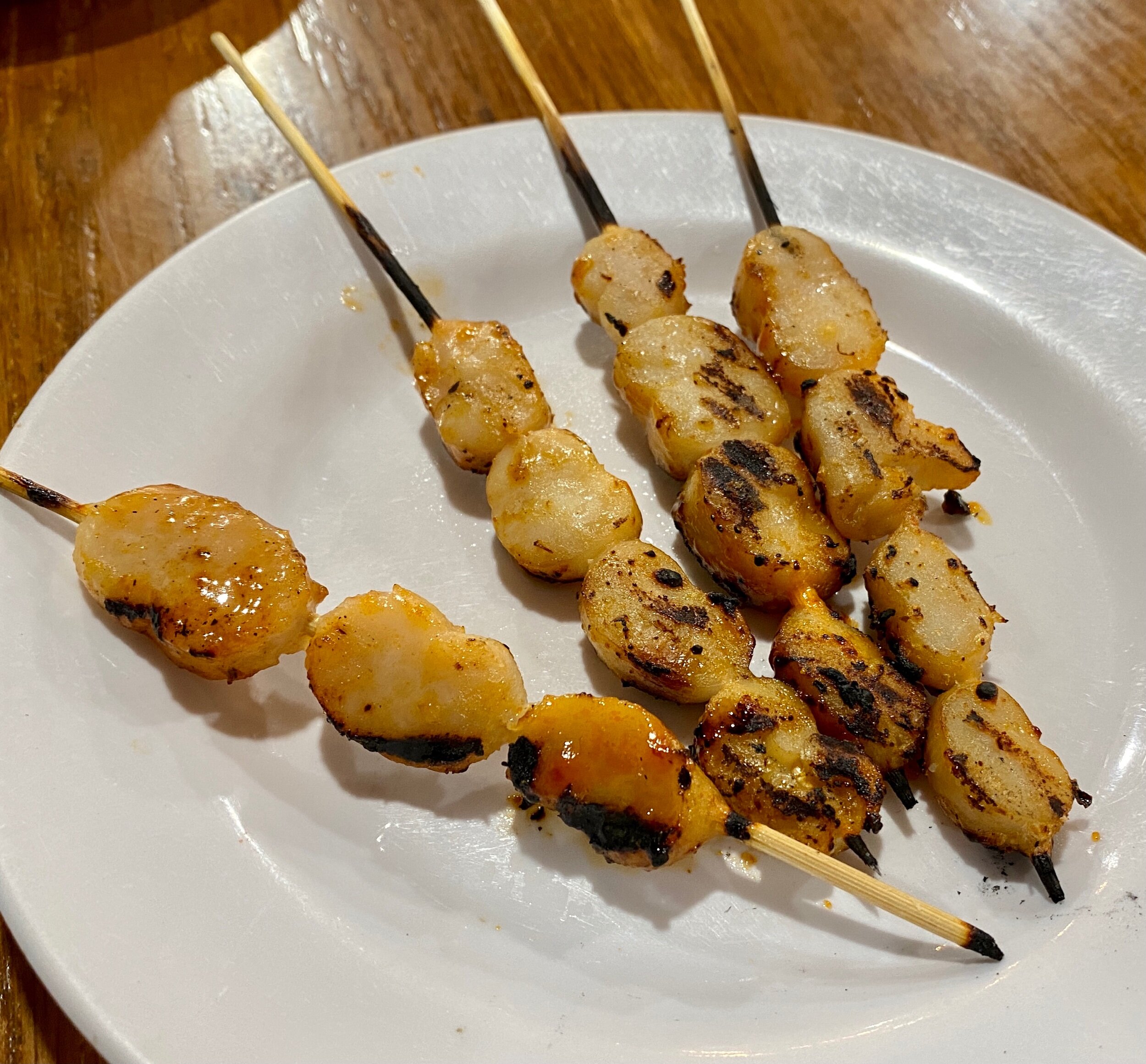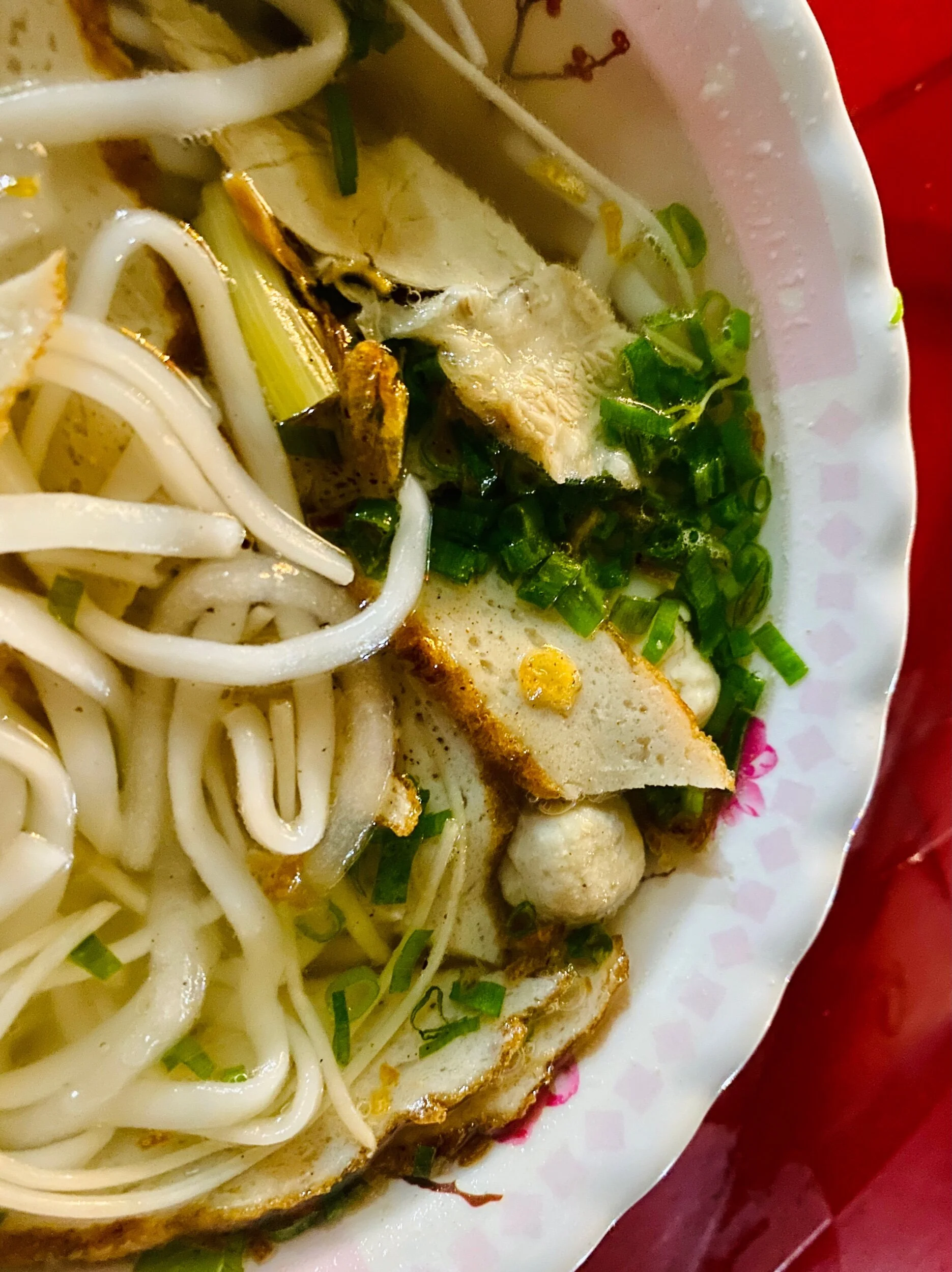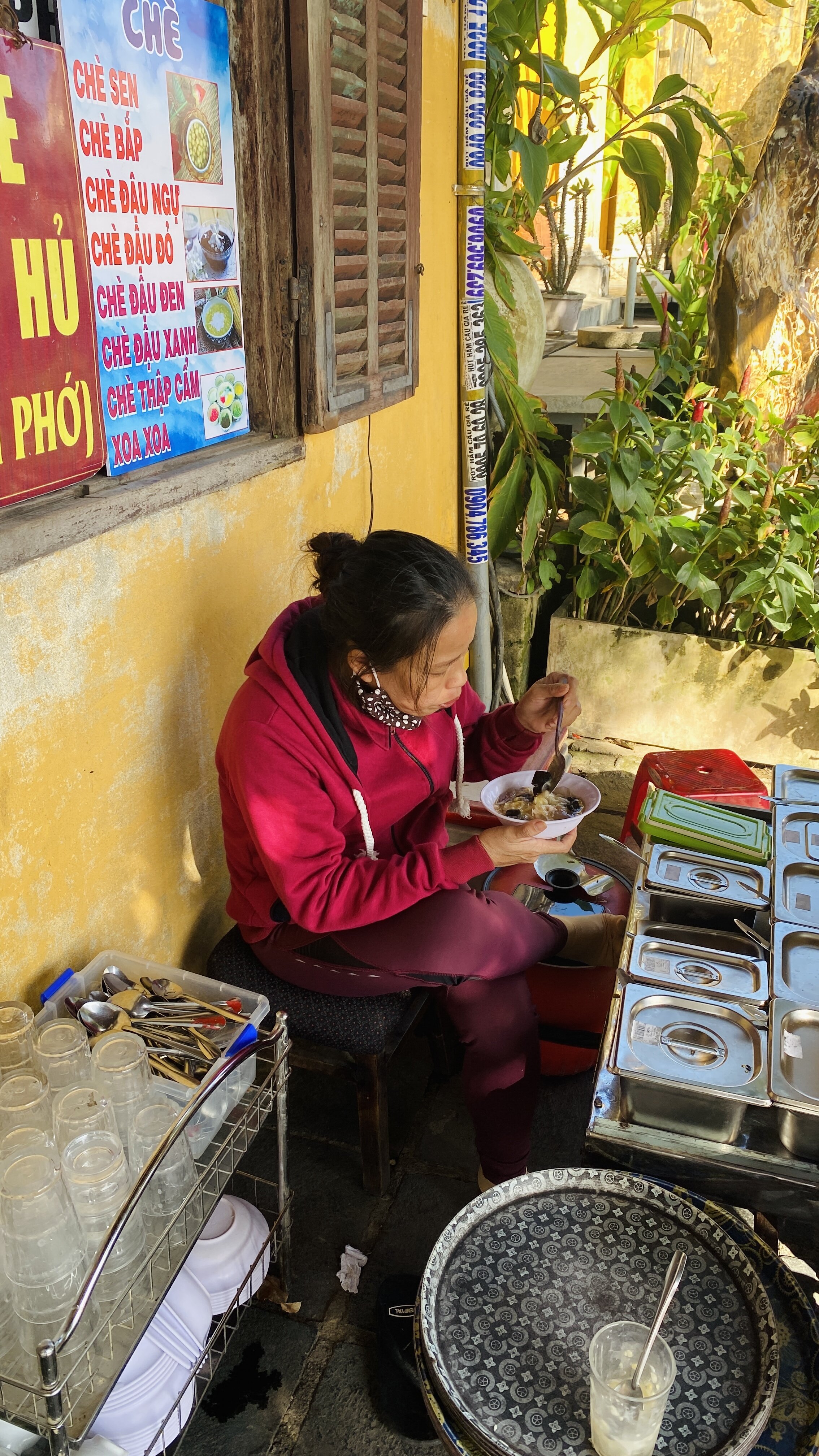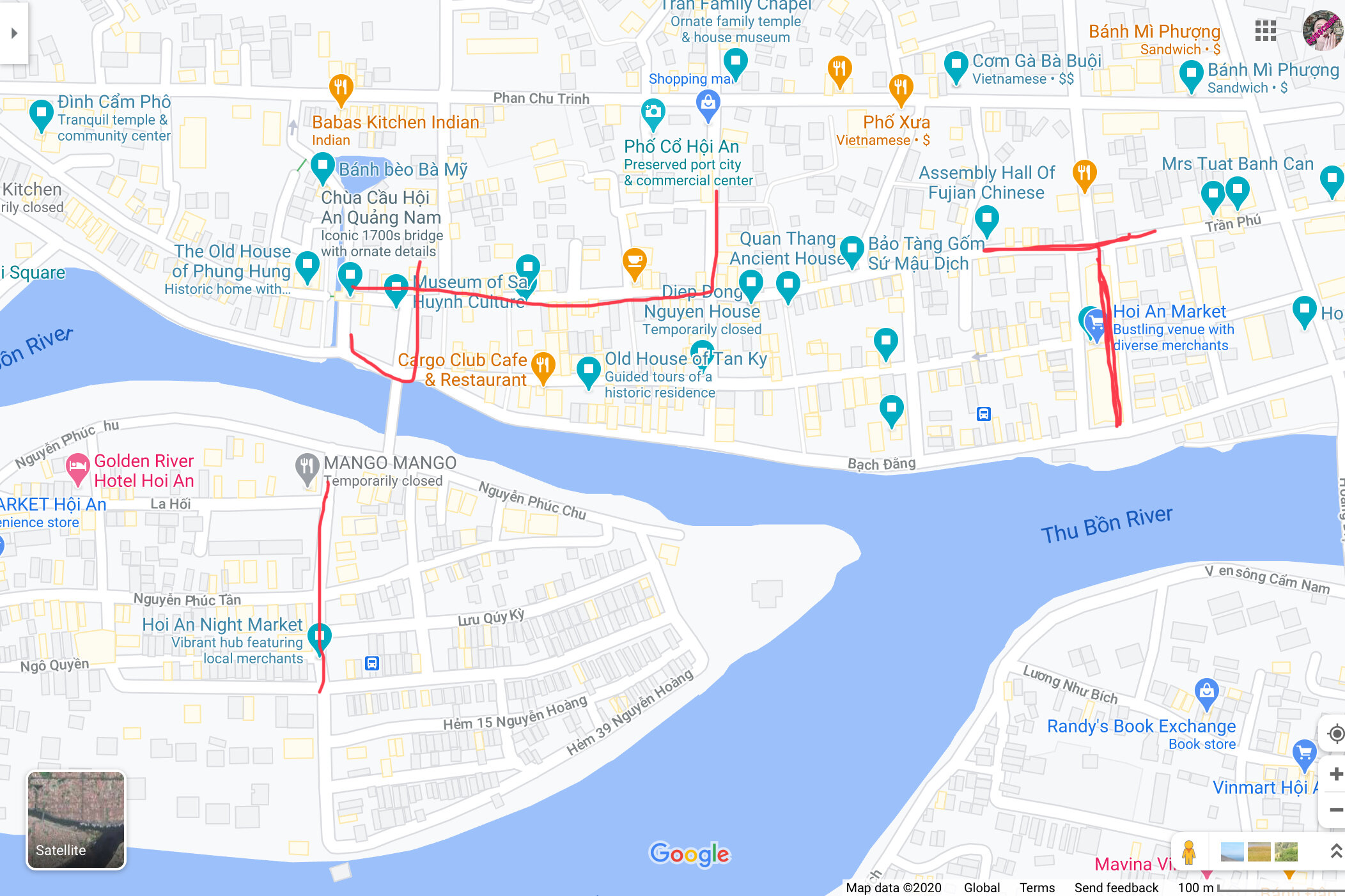My tuktuk driver wanted to pop into the market near Bakong village one day. Not much to say about it, just snapped a few photos.
Phu Quốc Cuisine | Vietnam
Phu Quoc has such amazing food! I love seafood, so trying all the local cuisine was really a joy for me. I tried to rank them from most to least local, and rare to common. Phu Quoc has many indigenous species, in addition to more common species that would be exotic anywhere else, not to mention local styles of cooking. So, ordering them wasn’t an easy task! If you visit Phu Quoc, definitely budget for restaurants. If you are only on the island for a short time, the hands down best restaurant is Nhà Hàng Hải Sản Xin Chào at 66 Đường Trần Hưng Đạo, TT. Dương Đông, Phú Quốc.
And here’s a link to my google map of everywhere worth going on the island, including restaurants: Genevieve Fields' Phu Quoc
1. Ghẹ Hàm Ninh (Flower Crab)
Ham Ninh’s indigenous crabs, usually called flower crabs but sometimes guard crabs (a direct translation from their name in Vietnamese), are known for being particularly sweet; it’s best to choose medium sized crabs as they tend to be sweeter than larger crabs.
While I adore lobster and shrimp, I’ve never been much for crab because they’re so much work and mess for such little meat! I prefer soft shell crabs, and crabcakes. Though the Ham Ninh crab is tasty, I didn’t find its flavor special, and it was certainly nothing different enough to be “worth” the table work.
2. Canh Nấm Tràm (Boletus Mushroom Soup)
These particular mushrooms only bloom on paperbark trees in the island’s primary forest after early spring (March, April) rains. So, despite their bitter taste, their rarity makes them an expensive seasonal item. They are always cooked in a bland seafood soup with shrimp and squid. Again, I’m very pleased to have tried this local specialty but wouldn’t go out of my way for it.
3. Tôm Mũ Ni (Slipper Lobster)
Slipper lobster is yet another species indigenous to the island, and the taste and texture is sort of halfway between shrimp and lobster. In my opinion, giant shrimp are more satisfying when simply dressed and grilled, and the flavor and size of Western lobsters is far superior. However, if you’re craving more of a lobster flavor and don’t have the budget for true lobster, these are a reasonable choice. For $20 you can have 4 or 5 slipper lobsters grilled.
4. Còi Biên Mai (Horn Scallop Sinew)
Rare anywhere else, horn scallop sinews are cheap and bountiful on Phu Quoc. Though they’re called scallops, they’re actually the sinew connecting the scallop to its shell. The meat of these big triangular scallops just doesn’t taste very good, so the sinews are what’s grilled and eaten. They can be purchased for $2-3/skewer at the night market, or at beach bars frequented by locals. I love scallops and I loved these! They taste like scallops, perhaps less strong; I didn’t notice any particularly novel flavor and they could shine in many preparations. I would absolutely eat these again.
5. ốc Giác (Baler Snail)
Baler snails are giant; the meat alone is typically as large as a man’s fist. Due to their size, they have to be prepared carefully in order to not go rubbery. One of the more popular and successful preparations is thinly sliced and sautéed with onions and banana leaves. Some people prefer them grilled or boiled, and also eat the roe. For me, these were just OK. The flavor was mild, sort of mushroomy, fine but I would not seek it out again.
6. Bào Ngư (Abalone)
I’ve always thought of abalone as a shell, ideal for buttons or small household objects. I never considered eating them! They are really tasty, with a more delicate taste than clams or mussels, subtly smoky, closer to oysters but not as vinegar. The beautiful shells remaining on the dish at the end of the meal is a bonus. I would definitely order these again if I saw them on a menu.
7. Mực (Fried Squid)
I have never liked calamari, but was promised the squid here was super fresh and tender. It did not disappoint! If I go back I will try to have the egg squid, a seasonal specialty.
8. Gỏi Cá Trích (Raw Herring Salad)
Raw herring salad is possibly the island’s best known recipe, and the one I felt most apprehensive about trying. I needn’t have! Tossed with shredded coconut and wrapped with pineapple, rice noodles, green papaya, carrots, lettuce, mint and peanuts, then dipped in a slightly sweet sauce, it’s incredibly refreshing. It’s perfect for lunch on a warm day.
9. Bún Quậy (Noodle Soup with Shrimp Cakes and Squid)
This dish has been an island breakfast favorite for around 100 years. The base is white rice noodles with bland seafood broth; the deluxe version includes shrimp cakes, fish cakes, and a boiled squid for 55,000 dong, though you can order it without the squid or with just one type of cake if you prefer. The gimmick here is that you make your own sauce with soup powder, chili, msg, sugar and a squeezed kumquat, and add to your soup to taste.
10. Canh Chua Cá Bớp (Sweet and Sour Cobia Soup)
Cobia is the most popular fish on the island. It reminds me a bit of swordfish. I don’t love it, and this soup base is pretty straightforward. Meh!
11. Vỏ ốc (Conch)
One of my favorite meals of all time was in Key West over 20 years ago now, the conch at Café des Artistes. I don’t remember much about the preparation, only that it was the first time I’d tried conch, and it was absolutely delicious! Obviously a beach joint in semi-rural Vietnam is not going to share much with a truly fine French restaurant, but I was still really surprised by how little I enjoyed the conch here. It was inedibly rubbery. Is conch typically that way, or did they ruin it?
12. Nhum Biển (Sea Urchin)
Sea urchins have a rich, almost beefy taste that I love. They’re typically just grilled over charcoal with a bit of onions, oil and peanuts, though I’ve also had them with an egg fried in (an unfortunate flavor masking preparation that is used for shellfish with alarming frequency in Vietnam). There is usually a small and large size on offer, and the larger ones are meatier and have a stronger taste, which I prefer.
13. ốc Nhảy (Jumping Snail)
My pictures disguise how small these snails are! You have to pick out the meat with a safety pin, paperclip, toothpick, sharpened old chicken bone, or the like. I love eating snails, but snails this small are hard work! This type of snail is considered beer food in Vietnam and is available cheaply in the market, at roadside stands, and pretty much any restaurant. They’re typically boiled before eating. Not worth it for me, but a must try if you want to eat like the locals.
14. Bánh Canh Ca Thu (Mackerel Fish Cake Soup)
Banh canh is an ubiquitous style of Vietnamese soup with tapioca flour noodles or half rice/half tapioca flour noodles. All coastal areas will offer this soup with fish broth, and what goes in the bowl depends on the restaurant: fish balls, fish cakes, fried fish cakes, chunks of fresh fish, fried fish filets, a combo of fish cakes and pork or pork sausage, etc. This is a common lunch or dinner food, and typically costs 40,000 dong ($1.75) or less.What makes it famously good on Phu Quoc is the quality of the fish; not only can you get deluxe versions with crab or tuna, but even the cheap versions made with bits of miscellaneous fish and fish balls are relatively good. If you don’t have money to spend, you’re in a rush, or you’re looking for a homemade meal a little bit too late at night, this is a good choice.
And on my list for next time:
Tiết Canh Cua (Crab Blood Pudding)
Hải Sâm (Sea Cucumber)
Ca Thu (Grilled Mackerel)
ốc Gai (Barbed Snails)
Bánh tét mật cật Phú Quốc (Phú Quốc New Year’s Cake)
Mực Trứng (Egg Squid)
Bún Kèn (Ken Noodles)
Hội An Street Food | Vietnam
I typically shy away from street food. Of course the hygiene is questionable relative to a restaurant . . . Where does the server wash their hands, particularly after using the restroom? How are they washing utensils? Also, as a Westerner, any stand without posted prices will charge me much more than a local: walking in Hội An Old Town with my Vietnamese friends, a serving of anything is 15,000 dong; on my own, it’s 30,000 or 40,000. For reference, a sit down meal can be bought at a non-tourist restaurant for 35,000.
Even when I’m willing to risk my health and accept being scammed in the name of experiencing local culture, the element that typically makes me skip street food is the street itself: squatting at exhaust pipe height amongst chainsmoking locals, trash bags piled around every tree and sometimes burning in the street, is enough to make me feel ill before eating at all. The setting makes it pretty difficult to appreciate good flavors, and anything aggressively pungent can quickly become nauseating.
I was recently willing to give street food a chance in Hội An, because this discomfort factor has been mitigated by the Covid pandemic. Nine months after borders closed, and less than a month after several severe floods, this extremely tourist reliant town is dead, hands down the quietest of any I’ve visited in the country. There is no crowding and very little traffic; I could easily take my street food, walk a block and eat quietly in front of a boarded up museum, without aggressive scooter drivers or souvenir hawkers bothering me.
Hội An is also particularly well known for its local specialties, and with no tourists the street food is currently in its totally authentic state (sometimes food served to white people in tourist areas is prepared extra bland, extra sweet, or drowned in soy sauce, which obviously doesn’t appeal).
Spoiler alert: I still greatly prefer restaurants, and I’ll cover the best restaurants and must-try local dishes of Hội An in a separate post. Still, there is such vlogger/blogger/foodie fervor over Vietnamese street food that I’m glad I tried a lot of it.
I have 4 ‘ratings’:
Yuck
Meh
Would Eat Again
Wow
Here are my thoughts!
Bánh Bột Lọc
MEH.
These tiny dumplings have stretchy, tasteless rice wrappers and are filled with either a tiny, unshelled shrimp (you eat the head, tail and all, for a crunchy effect) or a lump of meat paste that I later learned was pork but was honestly indiscernible to me by taste alone. These were boring and made edible solely by the generous topping of fish sauce, chili jam and fried onions.
Bánh Xoài
MEH.
These are the infamous mango-free “mango cakes”: thick, glutinous rice balls dusted in powdered sugar or flour (very mochi-like) and filled with roughly ground peanuts, granulated sugar, and a bit of cinnamon if you’re lucky. If Bánh Mì is the Việt equivalent of a breakfast sandwich, these are Việt donuts: you snag one or two and eat them standing up on the corner, coffee (or tea) in the other hand, regretting it more with every bite. The sugar is so rough that I was genuinely concerned about cracking a tooth! And dare I say they don’t look like mangoes either?
Chè Bắp
would eat again.
There are about a trillion kinds of chè; the wikipedia page is quite illustrative if you are curious. The most common is definitely Chè Bắp, a corn and tapioca starch pudding drizzled with coconut cream. It’s served hot and cold, and is tasty both ways. It’s sweet, but not too sweet, and was good enough for me to experiment with some other types of chè . . .
Chè Thịt Quay
WOULD EAT AGAIN.
These are small glutinous rice balls filled with tiny bits of roasted pork, floating in a hot sugary broth seasoned with sesame, ginger and sometimes cinnamon. The contrast of sweet and salty is great; this reminds me of the flavors in a traditional moon cake.
Chè Hạt Sen
Would eat again.
To me, the least interesting types of chè are those served with jellies over ice. However, I approach my food listicles as a completionist, and these were clearly the most popular versions. I heard somewhere that lotus seed chè was trendy cuisine in the 19th c. Imperial City, which is almost correct: the imperial chè was actually lotus seed stuffed longans in vanilla and jasmine flower soup (needless to say, too expensive and time consuming for street vendors to bother with). I still really enjoyed my poor man’s version, which was a nice balance of sweet and starchy. As the ice melted into the syrup, it became a really refreshing drink. It opened my mind to the various bean iterations on offer . . .
It’s official: I’m a chè convert.
Đậu Hũ
Meh.
Đậu Hũ, Đậu Phũ, Tào phớ and Tàu phớ are all transliterations of “tofu”, and refer to the same dish. The dessert features a slightly sweet soy custard topped with oversweet runny caramel syrup, miscellaneous jellies, and occasionally a spoonful of chè (the above pictured has chè đậu xanh, or mung bean pudding) or shaved coconut. It’s served either hot or over ice. It’s so pretty that I really wanted to like it. It also tasted so familiar, so nostalgic, that I bought it from three different vendors despite not really liking it, trying to place it . . .
Flan. It’s the mediocre flan your second generation Puerto Rican aunt would bring to your birthday party and everyone ate because she tried and she’s an RN and no one is good at everything so be nice! A forgettable prelude to the Carvel cake. My favorite was Fudgie the Whale. Also, this could be a lot better with half-frozen berries on top instead of almost flavorless jellies. Anyway . . .
Bánh Tráng Nướng
Wow.
Your choice of seasoned dried beef, shrimp or chicken (I chose shrimp and chicken) are layered with green onions atop a thin fermented rice shell. The heat is turned on, a quail egg is cracked on top and cooks as it flows into and blends the other ingredients, and the whole thing is finished with a drizzle each of mayo and chili sauce. If you’re sitting down to eat it’s served open faced; if you get it to go it will be folded over, quickly flipped and handed to you in a paper pocket. Yet another Việt street food with a hmmm . .. kinda I guess? English nickname, this is commonly referred to as ‘Vietnamese pizza”. It’s much closer to a tostada, in my opinion. Delicious!
Bánh Khọt
Wow.
Dung is the place in town to go for bánh khọt, with foodies and locals packing her stand all day. She also has two employees frying and packing the shells for wholesale to restaurants. The shells are made of rice flour, corn starch, and coconut milk, tinged yellow with turmeric, and fried in a griddle. The filling is typically fried egg, and deluxe versions can include a shrimp or shredded chicken. The whole thing is topped off with fresh veggies, and enough nước mắm pha to make a soup at the bottom of the bowl. This meal gives the satisfaction of fried food, but I find it much less heavy and oily than bánh xèo. Dung doesn’t serve shrimp or chicken, but tops her dish off with a generous slice of fried pork, for a salty/sweet contrast and a really filling meal.
Xí Mà
Would eat again.
This sweet black soup is surprisingly elusive. It’s served by one family only; they grow sesame plants in their garden and make the soup with water from the Bá Lễ well, which is only a few steps from their home. It’s served to tourists as part of a cooking demonstration in their kitchen, and to locals on the sidewalk across from the Catholic Church.
It’s considered a special occasion when the octogenarians (who started selling the soup 50 years ago) get out on the sidewalk and sell themselves; it’s usually the younger generation who will do it now. The simplicity of this soup and it’s low price (10,000 dong/bowl) have made it a popular local breakfast for many years. I like it enough to buy if the family is out that day and I happen past, but not enough to look and look for it on different days, at different times, many days in a row, as I had to.
Trái Cây
Wow.
Probably the healthiest street food ever, fruit cups are simple: pick your fruit (mango, guava, watermelon, avocado, dragonfruit, pineapple, etc.) then choose sweet or spicy. Sweet is dressed with a drizzle of chocolate or caramel syrup; spicy is dressed with a red pepper or chili based syrup, then shaken. My favorite (pictured here) is spicy mango.
Bánh Dừa Nướng
Would eat again.
These are French crèpes in a different shape; it’s the exact same taste and texture, but instead of the folded envelope/cone I’m used to, the dough was artfully shaped into a sort of clamshell. The filling is shaved coconut, toasted peanuts and a bit of chocolate syrup; nothing special, but satisfying nonetheless if you like sweets.
Kem Khói Hàn Quốc
Yuck.
Hàn Quốc means Korean, and this dessert is definitely as flashy and trendy as everything else that seems to filter down to Vietnam from Kpop culture. I had to look up what exactly this is, because it wasn’t ice cream as advertised! Truly light as air, fried yet completely flavorless, the brightly dyed balls are drizzled with chocolate syrup and disgustingly sweet strawberry flavored syrup. Then, the whole thing is sprayed with liquid nitrogen, instantly freezing it and creating the smoke effect.
If you eat it before the smoke dissipates, the smoke will come out of your nose and mouth while you eat and breathe, so this is marketed as ‘dragon’s breath ice cream.’ It looks cool, but could look a lot better with more sophisticated shapes and colors. It tastes awful; all I could taste was the saccharine over-sweetness of the fake strawberry syrup. I was done after 3 or 4 balls, but it still left my mouth feeling numb and coated. This is more an edible toy for children and Instagrammers than food.
Khoai Tây
Meh.
These seemed to be the least popular option in the tourist area and the most common option in the non-tourist area, so I was curious. They’re grilled cakes of mashed sweet potatoes mixed with a few small bits of banana, coconut, or green beans. They don’t taste great and they don’t taste bad; they really don’t taste much different than the rinsed and grilled whole sweet potatoes you can buy for the same price three feet away.
They would taste a lot better deep fried, or at least buttered before they were grilled; they could really take off with both bigger bits of fruit and more creative choices, like pineapple, or caramelized peppers and onions, or blueberries. However, these are an old-fashioned subsistence food for locals who need to eat on $1-2/day, not an experimental foodie culture item.
Where to Buy Street Food
Street food is truly ubiquitous in Hội An; I genuinely don’t think you could walk down a single block without passing a vendor. If you have as little as 20,000 dong (less than $1) you will not go hungry here. It’s sometimes difficult to find the same vendor twice because most will rotate within the same couple blocks just for variety, and others get shuffled off their corners every now and then by police officers cracking down on unlicensed sellers. However, if you are looking to try a large variety of foods without walking too far, these are the hubs:
All Hours:
Châu Thượng Văn, for the whole block north of the Bridge of Lights, is packed with sellers at all hours; they spread out heading towards the Japanese covered bridge along the river, and stretch west along Trần Phú for a few blocks before turning northwards on Lê Lợi for a block or two.
Early Morning Only:
Chợ Hội An (the Hoi An market) has a really large indoor food court where local specialties are sold to locals (so extremely authentic foods and a lot of variety). However, it empties out after 10 AM, with 3/4 of the sellers going home, and by noon it’s just a few local businessmen eating lunch. On the north front of the market, and for a couple blocks of Trần Phú on either side of the entrance, are many more sellers.
Evening Only:
On An Hội island (across the Thu Bồn river from the old town) there is a nightly evening market on 2-3 blocks of Nguyễn Hoàng. They sell the local classics as well as more modern sweet treats like Nutella pancakes. There are also a couple bars here with live music and a nice evening scene. Things start up around 7:00 PM.



















































































